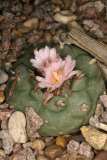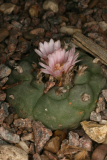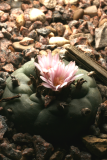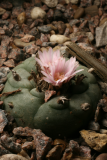Additional notes (click to expand)
Medicinal
Sacred, hallucinogenic to Huichol shamans who also used the plant on cuts and scratches as an antibiotic. Modern scientific research has proven this use.
Schultes, R.E.& Reis, Siri von, (1995) Ethnobotany. Evolution of a Discipline, Chapman and Hall p.109
Peyote has a long history of human use. The cactus contains the psychoactive alkaloid mescaline. It has been used to engender altered states of consciousness, possibly for as long as 7,000 years. It has a strong religious connection with the Huichol and Tarahumara in Mexico who make ritualised pilgrimages to collect it. In Huichol belief, the deer-god left peyote plants in its tracks. One Huichol man is quoted as saying: ‘peyote is the crossing of souls, it is everything that is. Without peyote nothing would exist’. Traditionally, the tops of plants are carefully cut off, allowing the plant the chance to re-grow. These pieces are then dried and eaten. Ingestion leads to feelings of extreme nausea followed by hallucinations.
https://herbaria.plants.ox.ac.uk https://herbaria.plants.ox.ac.uk/bol/plants400/Profiles/kl/Lophophora
Toxicity
contains mescaline, a psychoactive compound. It causes hallucinations characterised by vivid colouration of perceived environment.
Sequin, M. (2012). The Chemistry of Plants. Perfumes Pigments and Poisons. Royal Society of Chemistry, Cambridge, UK.
Toxic.
Professor Anthony Dayan, 2022
Humans/pets. Harmful if eaten.
The Horticultural Trades Association Guide to Potentially Harmful Plants 2022 https://hta.org.uk/poisonousplants
Geographical distribution
- Northern America
Lophophora williamsii (Lem. ex Salm-dyck) J.Coult.
Family: CACTACEAEGenus: Lophophora
Species: williamsii (Lem. ex Salm-dyck) J.Coult.
Common names: Mescal; Peyote
Distribution summary: Mexico; U.S.A.
Garden status: Currently grown
Garden location: Plants in pots (POT), Plants in pots (POT)
Reason for growing: Medicinal, toxic




